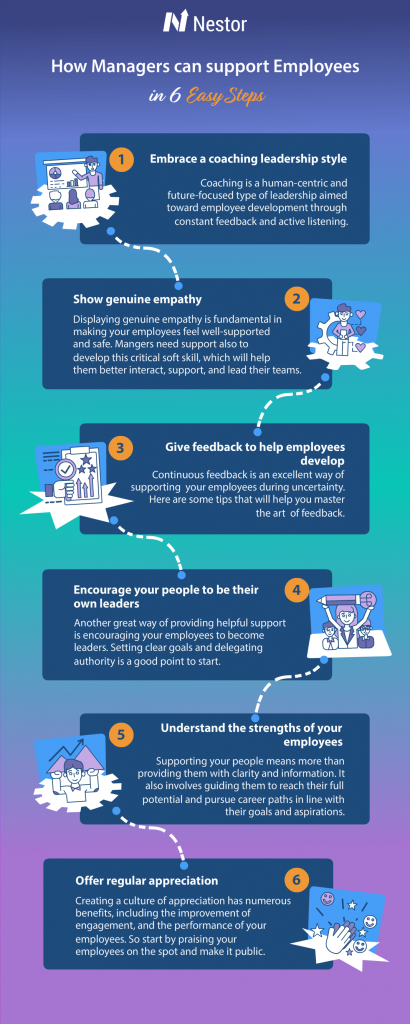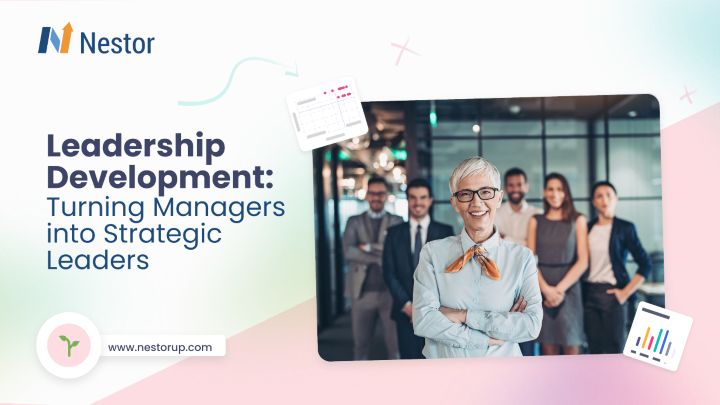How Can Managers Support Employees during Uncertainty (And Beyond)?
11 min read

One of the most challenging questions for HR experts and leaders is: “How can managers support employees?”, especially during uncertainty. And the current socio-economic situation, defined by increased levels of instability and change, has only made things more difficult.
But what do people actually expect from their managers during uncertain times? Well, according to a survey published in the MIT Sloan Management Review:
- information: e.g., performance expectations, return to the office
- transparency: e.g., potential lay-offs, reduced benefits
- support: e.g., job assurance, mental & physical health
Managers, on the other hand, find themselves in a tricky situation. That’s because, according to the study, different employees have different expectations. For example, some want their leaders to openly talk about concerns and difficult decisions, while others would like to see their leaders remain calm and unfazed by what’s happening.
Regardless, HR leaders and managers must find effective ways of providing this type of support, especially in today’s world. That’s why, in this article, we’ll look at the manager’s role, challenges, and some of the best ways to be supportive.
Managers’ double role: achieve business outcomes while also supporting people
The pandemic, the economic situation, and the new period of slow growth have all put a spotlight on the manager’s double role. While it’s always been clear that they are responsible for progress, results, and learnings, a different need came to the forefront:
Supporting your team members throughout uncertain times, even if, given their nature, these have been new and tough challenges for leaders as well.
Hybrid or remote work, employees overwhelmed by working from home and personal chores, the lack of connection and interaction, an increase in the number of virtual meetings, and productivity paranoia — all are real challenges, new challenges that managers have been facing and have had to address.
Still, being there for people couldn’t be more important during these times. And managers shouldn’t support their workforce just because it’s their duty or the right thing to do. They should do it because workers’ well-being and satisfaction will inevitably impact business outcomes.
And, indirectly, they will also affect the company’s decisions, actions, and social responsibility, which are more important than ever. According to Josh Bersin:
Coming out of the pandemic, ideas like sustainability, mission, and focus on moral values are becoming central. Is there a company in the world that doesn’t feel a responsibility to improve health, income inequality, climate, and the environment?
— Josh Bersin
In a way, the manager’s role hasn’t changed. The challenges have. And so have the expectations of their employees. In this situation, flexibility and adaptability are key, and while the concept of leadership itself may not need to change, leadership styles should adapt to the current realities in the world of work.
How can great managers support their employees?
The first step leaders can take to provide better support to employees is addressing the main desires and concerns according to the same MIT study:
- Offer Information: Your workforce needs to know how the company plans to respond to challenges, especially during uncertain times.
- Be Transparent: Even if negative news is on the horizon, employees would rather receive it sooner than later, so that they can prepare and make their plans accordingly.
- Provide Full Support: See the human behind the worker, and realize their struggles and pain points. Then try to identify ways to help them grow, both personally and professionally.
The additional steps we’ll look at below aim to build psychological safety and create an organizational culture of trust:

Embrace a coaching style of leadership
Coaching is the leadership style we wholeheartedly support and encourage here, at Nestor. It is a human-centric and future-focused type of leadership where managers become true mentors for their employees.
To successfully adopt the coaching leadership style, you, as a manager need to shift your focus toward:
- Employee development: Achieving business goals is still paramount, but with this approach, you get there through the constant development of your workforce.
- Long-term future: Coaches know that long-term success isn’t achieved by overnight changes. Instead, the focus is on strategic changes, backed by consistent actions and evaluations.
- Ongoing feedback: Ongoing feedback sessions will help your employees develop both professionally and personally. It will also contribute to building a work culture and relationships based on trust.
- Active listening: Active listening is an important part of coaching, and it starts with you, the manager, talking less and paying full attention to what the employee says.
The focus isn’t only on verbal communication but on non-verbal communication as well. Aspects like the tone of voice, body movements, and reactions can help you better understand what is being said. And more importantly, it also helps you realize what is not being said (but maybe implied).
To be successful in listening actively, the final step is leaving your agenda aside, along with any personal assumptions, biases, or judgments.
Show genuine empathy
Displaying genuine empathy is fundamental in making your employees feel well-supported and safe. And the best way to offer authentic empathy to others is to first offer it to yourself.
It’s easy to focus too much on other people and forget about your own emotional needs, as a manager or leader. That’s why you should get in touch with your feelings, appreciate your strengths, and understand your shortcomings.
When it comes to your employees, here are some of the ways to show genuine empathy according to some members of the Forbes Coaching Council:
- Ask powerful questions and listen to the answers
- Keep a list of what and to who you’re grateful for
- Help employees achieve goals that matter to them
- Practice identifying emotional states
- Use a personality assessment tool
- Slow down and take a pause
- Practice a self-awareness exercise
We recommend exploring the entire list from Forbes here.
HR departments should remember that these types of behaviors do not come naturally to most managers. Therefore, they also need support to enhance their leadership style and develop critical soft skills, which will help them better interact, support, and lead their teams.
By using surveys and skills assessments, you can identify their leadership style and areas where they need further improvement. This will allow you to make informed decisions about the appropriate training and development needed.
Give feedback to help employees develop
Continuous feedback is an excellent way of supporting your employees during uncertainty. It will create trustworthy connections and help build rapport, which is an essential part of healthy feedback sessions. Here are other tips and tricks to master the art of giving feedback:
- Always ask for permission before giving feedback, and learn how, when, and how often each employee needs it.
- Prepare your positive & constructive feedback before the sessions, so that your thoughts are clear and you provide valuable insights.
- Remember that how you say something is often more important than what you say. This is why you should pay attention to your tone and observe the other person’s nonverbal communication cues.
- Avoid generalizations and highlight what your people can do better, instead of what they are doing wrong. The approach should be positive and future-oriented.
- Be aware of biases: you, I, and everybody else interpret events and actions based on our own filters and life experiences. When giving feedback, always question your personal biases.
- Ask for feedback after each session. You’ll learn how to improve and offer each employee better and more effective insights.
Encourage your people to be their own leaders
Another great way of providing helpful support is encouraging your employees to become leaders. Although a slow process, in time, it will help improve the work atmosphere and increase people’s motivation. Here’s what you can do, as a manager:
- Ask employees to come up with potential solutions to a problem before coming to you. Not only will this improve their critical thinking, but it will also help them act as problem solvers, an essential quality of any leader.
- Clear goals: Define both individual and team goals together with your people. It’s a process that involves discussing and setting goals that are reasonable and achievable.
- Delegate authority together with tasks to employees who show the desire or potential to become leaders. These minor roles of authority are also proof of your trust and allow them to further develop their leadership skills.
- Publicly praise employees who step beyond their current roles and take on new responsibilities. This will encourage them to continue and will give others the necessary motivation to be more proactive.
Understand the strengths of your employees
Supporting your people means more than providing them with clarity and information. It also involves guiding them to reach their full potential and pursue career paths in line with their goals and aspirations.
And having a clear understanding of employees’ strengths and weaknesses is the first step to achieving that. Here’s how you can develop this understanding:
- Map out skills: It’s the first step in discovering the possibilities and limitations of your workforce. Overlapping them with the company’s roles, projects, and objectives will then enable you to identify gaps and get strategic about which capabilities to prioritize for a bigger impact. This will allow you to create and assign development goals for employees, and initiate learning, mentorship programs, or additional training as needed.
- Ensure that all development opportunities are visible to your employees. Some employees may not be able to openly share what they are good at or interested in. This can be due to any number of personal reasons, like low self-esteem. Technology can remove these barriers and empower employees to explore internal career opportunities and development initiatives on their own. By collecting all available opportunities, such as short-term assignments, cross-functional projects, new job roles, and mentorships, in a single place like a talent marketplace, you democratize access and give employees the visibility they need to explore various possibilities within the company.
- Use peer feedback: In some situations, you might have a better chance of identifying individual strengths by listening to positive feedback from an employee’s colleagues. If they work together daily or have collaborated on numerous projects, the insights will be more valuable and relevant. Building a culture of public recognition and reward will enable this successful peer feedback process.
Offer regular appreciation
Creating a culture of appreciation has numerous benefits, including the improvement of morale, engagement, and the performance of your employees. While there are many ways to show appreciation, here are a few worth trying:
- Praise on the spot: We recommend appreciating somebody’s accomplishments or great work as soon as they happen. It’s a bulletproof way of preventing other projects or events from taking the spotlight, which isn’t uncommon in the fast world of work.
- Make it public: In some situations, an in-person or one-on-one praise session will do. But in others, either verbal or written public appreciation will make the employee feel recognized and even more engaged. Public recognition also helps to:
- Create a culture of appreciation: this type of culture can only emerge through deliberate and constant displays of appreciation. Celebrating every win, being grateful for progress, and encouraging mutual appreciation are the steps to get there.
- Offer rewards as incentives: A few worthwhile rewards can go a long way in making appreciation feel even more substantial. Rewards can take the form of time off, financial compensation, or simply leaving early on Friday and buying dinner for your team.
How Nestor can help managers support their employees
One of the key ideas from the survey published in the MIT Sloan Management Review, mentioned at the beginning of this article, is:
Managers can respond to these diverging needs by identifying and addressing the unique needs of each employee, as well as cultivating trust with their reports.
And this is where Nestor steps in. Our People Intelligence Platform can help managers with actionable insights based on people’s performance, engagement, and interactions in the workplace and address the individual needs of each employee. This way managers can provide their people with support and guidance to grow in their roles, access meaningful development opportunities, and feel valued and fulfilled at work.










